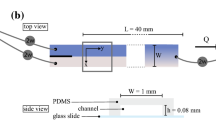Summary
Equations are derived for describing rates of solute absorption from tissue depots by capillary blood. One form of the generalized equation is:
where
M=amount of a reference solute present in a tissue at any time;
\(\dot M\)=rate at whichM is changing;
n=number of actively perfused capillaries per unit volume of tissue;
b=blood flow per actively perfused capillary;
λ=f b/fe, wheref b andf e represent activity coefficients for the solute in blood and extravascular tissue respectively;
a=capillary surface area available for solute absorption per capillary;
k=permeability constant of the capillary wall for the permeant species of the reference solute.
The symbolsk, a andb represent appropriately weighted means characteristic of the entire population of perfused capillaries within each and every elemental volume of tissue, as defined formally in the derivation. The equation is examined in reference to experimental data on the absorption of radioxenon and sodium radioiodide injected into the gastrocnemius muscle of anesthetized cats. The results indicate that rates of radioidide absorption from this tissue site are considerably diffusion- or permeability-limited even at resting levels of blood flow.
Similar content being viewed by others
References
Altman, P. L.: Handbook of Circulation, ed. by D. S. Dittmer and R. M. Grebe, p. 71. Philadelphia: W. B. Saunders 1959.
Bohr, C.: Über die spezifische Tätigkeit der Lungen bei der respiratorischen Gasaufnahme und ihr Verhalten zu der durch die Alveolarwand stattfindenden Gasdiffusion. Skand. Arch. Physiol.22, 221–280 (1909).
Carr, C. W.: Studies on the binding of small ions in protein solutions with the use of membrane electrodes. I. The binding of the chloride ion and other inorganic anions in solutions of serum albumin. Arch. Biochem.39, 286–294 (1952).
Conn, H. L., Jr.: Equilibrium distribution of radioxenon in tissue: Xenon-hemoglobin association curve. J. appl. Physiol.16, 1065–1070 (1961).
Gosselin, R. E.: Local effects of catecholamines on radioiodide clearance, in skeletal muscle. Amer. J. Physiol.210, 885–892 (1966).
—: The tissue tracer injection method for assessing capillary permeability. Capillary permeability, ed. C. Crone and N. A. Lassen (Alfred Benzon Symposium II). Copenhagen: Munksgaard 1970.
Gosselin, R. E., Audino, L. F.: Muscle blood flow and functional capillary density evaluated by isotope clearance. Ann. N. Y. Acad. Sci. (submitted for publication).
Hills, B. A.: Diffusion versus blood perfusion in limiting the rate of uptake of inert non-polar gases by skeletal rabbit muscle. Clin. Sci.33, 67–87 (1967).
Johnson, P. C., Wayland, H.: Regulation of blood flow in single capillaries. Amer. J. Physiol.212, 1405–1415 (1967).
Kety, S. S.: Measurement of regional circulation by local clearance of radioactive sodium. Amer. Heart J.38, 321–328 (1949).
—: The theory and applications of the exchange of inert gas at the lungs and tissues. Pharmacol. Rev.3, 1–41 (1951).
Kjellmer, I., Lindbjerg, I., Prerovsky, I., Tonnesen, H.: The relation between blood flow in an isolated muscle measured with the Xe133 clearance and a direct recording technique. Acta physiol. scand.69, 69–78 (1967).
Lassen, N. A., Lindbjerg, I. F., Dahn, I.: Validity of the xenon133 method for measurement of muscle blood flow evaluated by simultaneous venous occlusion plethysmography. Circulat. Res.16, 287–293 (1965).
— Lassen, N. A., Lindbjerg, I. F., Munck, O.: Measurement of blood flow through skeletal muscle by intramuscular injection of xenon133. Lancet1964 I, 686–689.
Lawson, H. C.: The volume of blood — a critical examination of methods for its measurement. Handbook of physiology, circulation, Vol. I (edited by P. Dow and W. F. Hamilton), Washington, D.C., American Physiological Society, Chap. 3, pp. 23–49 (1961).
Majno, G., Palade, G. E., Schoefl, I.: Studies on inflammation. II. The site of action of histamine and serotonin along the vascular tree: a topographic study, Biophys. biochem. Cytol.11, 607–626 (1961).
Perl, W.: Heat and matter distribution in body tissues and the determination of tissue blood flow by local clearance methods. J. theoret. Biol.2, 201–235 (1962).
Perl, W.: An extension of the diffusion equation to include clearance by capillary blood flow. Ann. N. Y. Acad. Sci.108, 92–105 (1963).
Renkin, E. M.: Effects of blood flow on diffusion kinetics in isolated, perfused hindlegs of cats. Amer. J. Physiol.183, 125–136 (1955).
—: Transport of potassium-42 from blood to tissue in isolated mammalian skeletal muscles. Amer. J. Physiol.197, 1205–1210 (1959).
Sangren, W. C., Sheppard, C. W.: A mathematical derivation of the exchange of labeled substance between a liquid flowing in a vessel and an external compartment. Bull. math. Biophys.15, 387–394 (1953).
Schmidt, G. W.: A mathematical theory of capillary exchange as a function of tissue structure. Bull. math. Biophys.14, 229–263 (1952).
—: The time cours of capillary exchange. Bull. math. Biophys.15, 477–488 (1953).
Sejrsen, P., Tonnesen, K. H.: Inert gas diffusion method for measurement of blood flow using saturation techniques. Circulat. Res.22, 679–693 (1968).
Smith, P. K., Eisenman, A. J., Winkler A. W.: The permeability of human erythrocytes to radioactive chloride, and to bromide and iodide. J. biol. Chem.141, 555–561 (1941).
Sund, R. B., Shou, Jens: The determination of absorption rates from rat muscles: an experimental approach to kinetic descriptions. Acta pharmacol. (Kbh.)21, 313–325 (1964).
Tosteson, D. C.: Halide transport in red blood cells. Acta physiol. scand.46, 19–41 (1959).
Wallace, G. B., Brodie, B. B.: The distribution of administered iodide and thiocyanate in comparison with chloride, and their relation to body fluids. J. Pharmacol. exp. Ther.61, 397–411 (1937).
Yudilevich, D. L., Renkin E. M., Alvarez, O. A., Bravo, I.: Fractional extraction and transcapillary exchange during continuous and instantaneous tracer administration. Circulat. Res.23, 325–336 (1968).
Author information
Authors and Affiliations
Additional information
This study was supported in part by USPHS grant GM 11598 from the National Institute of General Medical Sciences. Portions of these date have been reported before [Fed. Proc.25, No. 2, 594 (1966)].
Rights and permissions
About this article
Cite this article
Gosselin, R.E., Stibitz, G.R. Rates of solute absorption from tissue depots: Theoretical considerations. Pflugers Arch. 318, 85–98 (1970). https://doi.org/10.1007/BF00586488
Received:
Issue Date:
DOI: https://doi.org/10.1007/BF00586488




